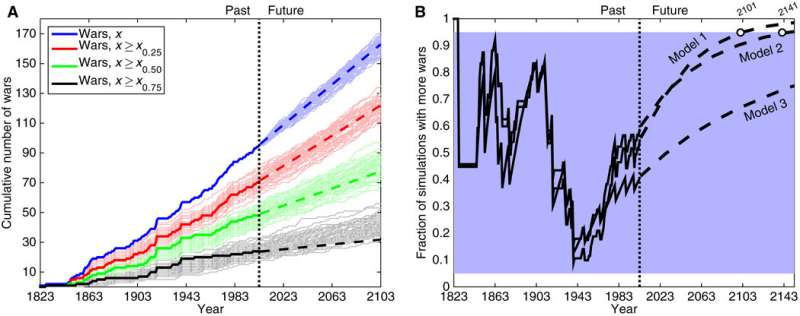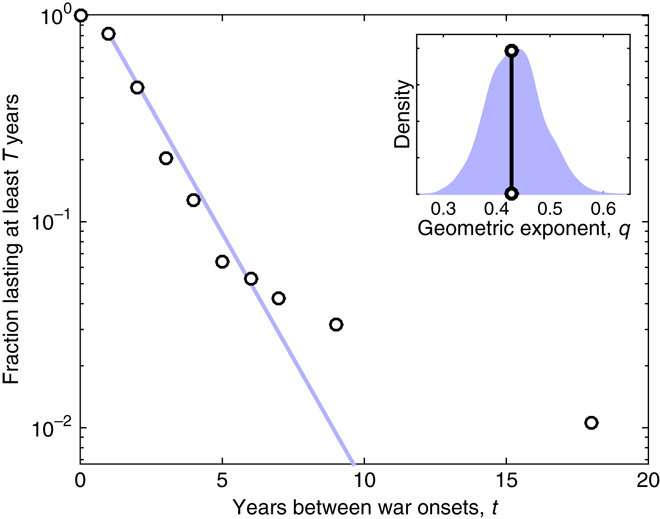February 22, 2018 report
A statistical look at the probability of future major wars

Aaron Clauset, an assistant professor and computer scientist at the University of Colorado, has taken a calculating look at the likelihood of a major war breaking out in the near future. In an article published on the open access site Science Advances, he describes his analysis of the history of human warfare using a large historical dataset, and offers his opinion on whether we are in the midst of a new era of peace, or if it just seems that way.
The world has not seen a major war since the end of WWII, over 70 years ago—a timespan that has some convinced that the human race has finally recognized the futility of large wars and is evolving into a more peaceful future. After all, we now live in an age of widespread democracy along with the knowledge of likely mutual destruction, or perhaps nuclear winter—a rather strong argument against war. But Clauset wondered if such a view based on too little information. To find out, he used data from the Correlates of War Project, a database that holds a massive amount of information regarding wars of the past several hundred years, to see if the current period is an anomaly, or just a blip on history's radar screen.
Clauset used the data to gauge statistical fluctuations over time, looking for trends. He also built several computer models to replay wars from the past and the time periods that followed such wars. He sought periods when people avoided major wars for long periods after prolonged conflicts, and whether other large wars occurred after such peaceful intervals. Sadly, he found that they did—and such wars have occurred often enough to indicate that the current peaceful period is not that rare—there is nothing special about it, he concludes. He therefore suggests that there is nothing in our past or present that might offer a reason to believe that we can avoid such conflicts in the near future. But, he also notes, if the current peaceful interval continues for perhaps another century, we might have a compelling argument for claiming we have really changed.

More information: Aaron Clauset. Trends and fluctuations in the severity of interstate wars, Science Advances (2018). DOI: 10.1126/sciadv.aao3580
Abstract
Since 1945, there have been relatively few large interstate wars, especially compared to the preceding 30 years, which included both World Wars. This pattern, sometimes called the long peace, is highly controversial. Does it represent an enduring trend caused by a genuine change in the underlying conflict-generating processes? Or is it consistent with a highly variable but otherwise stable system of conflict? Using the empirical distributions of interstate war sizes and onset times from 1823 to 2003, we parameterize stationary models of conflict generation that can distinguish trends from statistical fluctuations in the statistics of war. These models indicate that both the long peace and the period of great violence that preceded it are not statistically uncommon patterns in realistic but stationary conflict time series. This fact does not detract from the importance of the long peace or the proposed mechanisms that explain it. However, the models indicate that the postwar pattern of peace would need to endure at least another 100 to 140 years to become a statistically significant trend. This fact places an implicit upper bound on the magnitude of any change in the true likelihood of a large war after the end of the Second World War. The historical patterns of war thus seem to imply that the long peace may be substantially more fragile than proponents believe, despite recent efforts to identify mechanisms that reduce the likelihood of interstate wars.
Journal information: Science Advances
© 2018 Phys.org
















